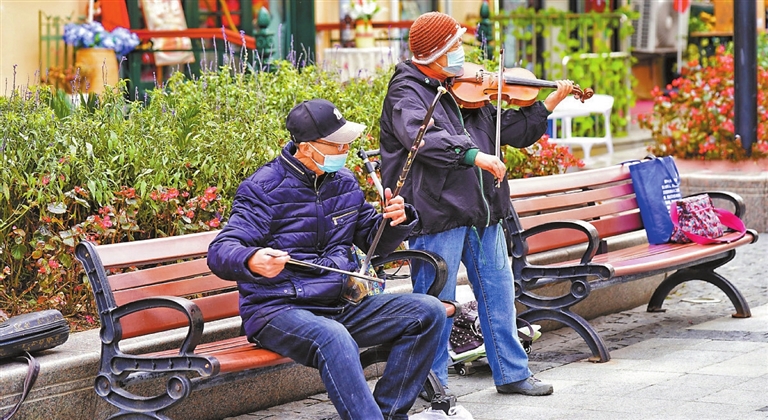
THE sight of amateur musicians playing violins, saxophones and even Chinese zithers alongside professionals in public squares and on the balconies of Central Street in Harbin, Heilongjiang Province, has become a unique tourist attraction. “Harbin is famed for its winter scenery, but I’m amazed by the variety of musical events in this city,” said Xie Yanwen, a tourist from Jiangsu Province. Music is deep-rooted in the history of Harbin, which is sometimes called China’s “Ice City.” At the Harbin Music Museum, traditional instruments like the erhu and the gehu are played alongside the violin and the piano, illustrating the stories of Chinese and Western musicians. For centuries, ethnic groups such as the Hezhe and the Oroqen built up a rich collection of folk songs and dances, and in the 20th century, the development of the Chinese Eastern Railway brought Western music to Harbin. Many European singers, performers and conductors moved to Harbin during the time, making it one of the first cities in China to embrace Western classical music. Many of China’s leading classical musicians were trained in Harbin or were taught by teachers trained there. “The convergence of Chinese and Western music shaped Harbin’s unique character, attracting connoisseurs from all over the world,” said Miao Di, curator of the Harbin Music Museum. As the longest-running musical event in China, the China-Harbin Summer Concert has been held for 35 years. Chinese songs like “On the Island of the Sun” and “I Love the Snow in the North” have been sung here and in concerts around the world. “Harbin’s musical heritage blends East and West. We want to revitalize this tradition and take it to a higher level,” said Sha Xiaodong, deputy director of the Harbin Cultural Broadcasting and Tourism Bureau. In recent years, the city has fostered the integration of fine art and public culture, giving residents more opportunities to pursue their musical aspirations. In March 2016, the brand-new Harbin Grand Theater opened to the public. The venue, resembling a silver ribbon in the sky, put on nearly 200 performances in a single year. That same year, the Harbin Conservatory of Music was set up on the north bank of the Songhua River. It is not unusual to encounter individuals playing violins, beating African drums or dancing to music at bus stops and public squares in Harbin. “The general public enjoys music and has good taste. They are both performers and listeners,” Sha said.(Xinhua) | 
